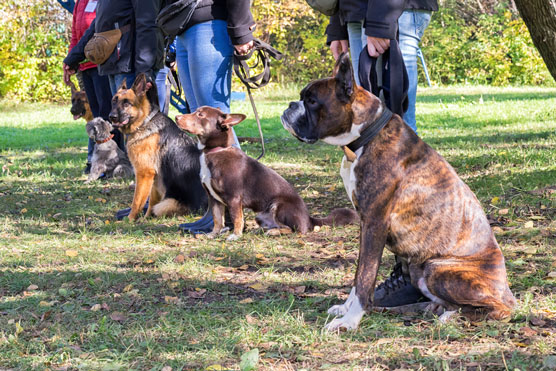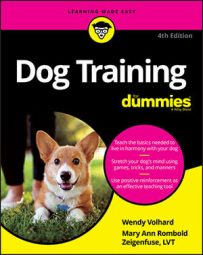
Our approach to training is for people who like their dogs and have them first and foremost as pets and companions or for people who want to like their dogs. Someone pointed this out us when she arrived for class. At that point she didn’t like her dog but wanted to make her child happy by having a dog. Either way, we like your dog and want him to be the best possible dog and you to be the best possible trainer for him.
The training involves three phases:
- The teaching phase: In the teaching phase, the dog is taught specific commands in an area free of distractions so he can focus on his owner and can be successful.
- The practicing phase: When the dog reliably responds to the commands he has learned, distractions are introduced. As the dog progresses in this practice phase, the distractions become increasingly more difficult in order to simulate real-life situations.
- The testing phase: In the testing phase, the dog is expected to demonstrate that he’s a well-mannered pet around other dogs and people.
The ultimate object of any training is to have your dog respond reliably to your commands. Ideally, he responds to your first command. Telling your dog to do something only to have him ignore you is frustrating. Think of Buddy’s response in terms of choices. Do you want to teach Buddy to think he has a choice of responding to you? You want a dog that understands — after you have taught him — that he must do what you tell him, no matter what is happening around him. A truly trained dog listens for your voice above all distractions.
Distractions do cause Buddy to struggle to hear your voice above other things as does the genetic influence of those things that Buddy was bred to do instinctively, that which is in harmony with his basic nature. Are all dogs the same to train or does the breed or mixture of breeds make a difference? Like people, dogs are individuals and have individual needs. Understanding breed characteristics and different teaching models helps to make the job of training that much easier.First things first: Consider your dog’s breed
Before you embark on your training program, consider what you want your dog to master, and then compare your answer to the task for which his breed was originally bred to do. Many people typically select their dogs based on appearance and without regard to breed-specific functions and behaviors. Whatever trait is in harmony with the breed of your dog is easier to teach or harder to break. For example, a Beagle uses his nose everywhere he goes. Teaching a Beagle to track or follow a scent is much easier than teaching a Greyhound to track. Greyhounds are bred to visualize movement rather than to sniff out prey.Although most dogs can be trained to obey basic obedience commands, breed-specific traits determine the ease or difficulty with which they can be trained. You also need to consider other traits, such as energy levels and grooming needs. High-energy dogs must have outlets for all of that energy. Chapter 20 discusses problems that occur if your dog doesn’t get the exercise he needs. After all, a tired dog is a happy dog, and a tired dog has a happy owner. As for grooming, brushing, bathing, and clipping of hair coats is time consuming and expensive if you hire a professional. For a dog to be healthy, the coat and skin needs to be cared for regularly.
An excellent resource for breed-specific behavior and traits is The Roger Caras Dog Book: A Complete Guide to Every AKC Breed, by Roger Caras and Alton Anderson (M. Evans & Company). For each breed, the book lists on a scale from 1 to 10 the three characteristics you should pay attention to: the amount of coat care required, the amount of exercise required, and the suitability for urban/apartment life.
Training a dog: What are you really doing?
When training a dog you’re either teaching him to do something (build a behavior) or not to do something (abstain from a behavior). For example, consider the Stay command. Are you teaching your dog to remain where he is or not to move from where he is? You can look at any command and ask this question. When training a dog, you’re usually building a behavior. Look at the following table to help understand.| Action | Abstention | |
| Build Behavior | Eliminate Behavior | |
| + | Positive Reinforcement (add good) | Positive Punishment (add bad) |
| – | Negative Reinforcement (avoid bad) | Negative Punishment (remove good |
We need to define two other words in terms of behavior:
- Reinforcement is used the building of a behavior
- Punishment is used in the abstaining of a behavior.
Reinforcement: Building a behavior
When training a dog, you want the dog to do something new and different. To do that, you need to motivate him by either giving him something he wants for doing the new task or getting him to avoid something he doesn’t want for not doing it. Consider the following:- Positive reinforcement (+) is adding something the dog wants in order to encourage him to do something he wouldn’t do on his own. For example, you want the dog to go upstairs, so you put a tiny treat on each step to induce the dog to go upstairs.
- Negative reinforcement (–) is eliciting a behavior the dog wouldn’t do on his own by making him avoid discomfort. The dog will do what is wanted because he wants to avoid the reinforcement from happening to him. For example, you want the dog to go upstairs, so someone gooses the dog’s behind to get him to go upstairs to avoid the discomfort of the pinch. At the top of the stairs, you praise him because he went upstairs.
Training comes with so many variables. The BBQ next door is a distraction, which is why it’s best to do early training when no distractions are around. The ability to climb the stairs or the difficulty of the task you’re teaching plays a big part on how willing your dog is. Buddy may suffer the consequences instead of climbing the stairs or jumping into a pool if water is too scary. Make sure you break the task you’re teaching into small parts to make it more easily understood and achievable.
You later can add distractions to the training after Buddy has learned the command. Distractions make the task more difficult for Buddy. When working with distractions, your dog needs to choose doing the task over being distracted. The object of distraction training is to train until your dog does the task no matter what is going on around him simply because you asked him to do so.
Punishment: Eliminating an unwanted behavior
When training a dog to stop doing an unwanted behavior, there should be a consequence. The consequence can be either adding something the dog doesn’t want or removing something he does want. Consider the following:- Positive punishment: Positive punishment adds an unwanted consequence (+) at the start of the bad behavior just as it begins. For example, as soon as a counter-surfing dog sniffs the edge of the counter, you can shake a bottle half-filled with pennies at the dog as an unpleasant consequence. (Oops: If the dog is already on the counter or eating off the counter, using the bottle with pennies is too late. The dog has been rewarded by getting the food off the counter. Because the Oops happened, the dog has learned to counter surf which is why it’s an Oops.) To eliminate the bad behavior, you must add something that the dog doesn’t want so he’ll avoid the penny shaker and not counter-surf. When the bad behavior stops, you don’t offer praise; you never want him to counter-surf, so don’t praise him for his wishing he could still get up on the counter to eat.
- Negative punishment: Negative punishment removes something (–) that the dog wanted because the dog behaved badly. For example, if a dog is jumping up on you when you come into the house, turn your back to the dog for a moment, removing your attention that he wants because he jumped up. Turn back toward him once more, and if he jumps again, spin around, removing your front, your facial expression, and your attention.

